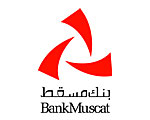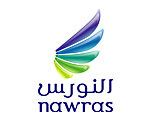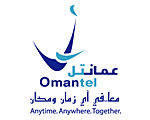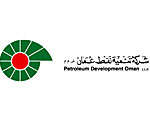Source: ITTS, www.itec.gov.om. Cisco Academy, mselinge@cisco.com
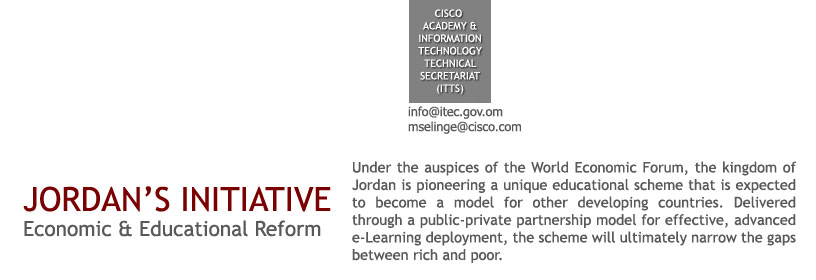
What is the Jordan Education Initiative (JEI)?
JEI is a collaborative programme that brings together over 30 public and private organisations - national and global - to transform the experience of learners at all levels and so achieve a more highly educated workforce. In addition to shaping a new educational model for schools via electronic content and Internet technologies, JEI aims to develop lifelong learning and to foster development of the local ICT industry.
The initiative is helping Jordan to achieve its vision of becoming a "knowledge economy." It is run under the aegis of the World Economic Forum (WEF), an independent, international organisation committed to improving the state of the world by engaging leaders in partnerships to shape global, regional and industry agendas; WEF members include Cisco Systems. The JEI is seen as a prototype, with the long-term intent to adapt the model for use in multiple developing countries.
How & Where did JEI Start?
The origins of the programme date back to an IT Governors' dinner at the WEF meeting in January 2003. Cisco CEO John Chambers invited business leaders from like-minded organisations to join Cisco in creating a high-quality education programme that would harness technology to lessen the gap between developed and less developed countries. Chambers' proposal led to the establishment of the JEI, formally launched in June 2003 and now supported by over 30 organisations, including Jordanian and international companies, Jordanian government departments, international government donors and NGOs.
The Kingdom of Jordan was chosen because, out of all developing countries, it was one of the most actively engaged in educational reform, which it sees both as inherently valuable to its people and as essential to its aim of creating a knowledge economy. The government's Educational Reform for a Knowledge Economy program (ERfKE) has among its objectives curriculum reform, teacher training, adoption of ICT as an enabler of learning, and upgrading of schools' ICT infrastructure - objectives that are all promoted and complemented by JEI.
Another pre-existing programme that fits well with JEI is Jordan's deployment of a National Broadband Learning and Research Network, which by 2006 will provide a "learning ecosystem" connecting 1.5 million people at schools, colleges, universities and community centres.
What’s Special About JEI?
This initiative has a number of unique features:
- JEI was always conceived as a global undertaking rather than a local one, and as a way of tackling overarching global problems such as poverty, rather than as an end in itself.
- The holistic and innovative education model emphasises solutions rather than products, and as such its solutions embrace non-technological aspects of educational reform, such as teacher training and change management.
- It is rooted in sound educational practice and uses technology not for its own sake but to transform the processes whereby teaching and learning take place, unleashing the creativity of both teachers and students.
- It has created high-quality electronic content - content that is specially designed to provide comprehensive support for both teachers and students.
- This support spans the whole learning process. In the case of teacher support, it addresses teacher training and continuing professional development, lesson planning and lesson delivery, through to assessment of, and feedback on, students' work.
- Because teachers are provided with wireless laptops and projectors, the electronic content can be used in every lesson and in ordinary classrooms as well as in computer labs, so ensuring that students and teachers gain maximum exposure to ICT.
Structurally, the initiative is unusual in being achieved through partnerships of several kinds, for example:
- There are collaborations between government departments and corporations - public-private partnerships on an unprecedented scale.
- The corporate philanthropy aspect of the programme, too, is being achieved through partnerships between many different companies.
- Jordanian and international organisations are collaborating on the development of the new electronic course materials.
The collaboration between local and international companies is illustrated by the Cisco-initiated and -funded mathematics e-curriculum, developed by the Cisco Learning Institute and a Jordanian company, Rubicon. In September 2004, "Mathematics On-Line" began to be deployed across 100 specially selected "Discovery Schools" in grades 1 to12.
This was the first in a set of e-Curricula sponsored by global corporations. New technology-enabled curricula, embodying the latest educational theory and research, are being created for several other core school subjects:
- Microsoft is sponsoring ICT
- Fastlink is sponsoring Science
- France Telecom is sponsoring Arabic
- MEPI is sponsoring English as a Foreign Language
The creators of each e-Curriculum are following a set of guidelines and standards developed by Cisco. The resultant e-Curricula will start to be piloted during 2005. In addition:
- IBM has donated some 150 "KidSmart" Early Learning units for use by kindergarten children.
- An extensive teacher training program, supported by Intel and World Links, is underway to help teachers to use the e-Curricula to promote active learning environments.
What are the Challenges?
Scope & timeline
The scope of a project for educational reform through the application of ICT is large and complex. To be effective, such a project needs to be holistic, covering at a minimum electronic content, teacher training and technology, all within a managed project and change management process. A large-scale implementation of this kind can easily take five to 10 years and cost tens of millions of dollars. In fact, Jordan will need to invest over US$100m (circa RO38.6m) over five years to provide the JEI solution to all 50,000 teachers and all one million students in its 3,200 schools.
Such a large project needs to be broken into manageable stages. A fast-track first stage, like that currently underway in Jordan through the JEI, provides an opportunity to "learn the ropes", as well as serving as a demonstrator for all stakeholders (who otherwise may struggle to grasp the concept of e-Learning). Later, a staged roll-out should follow, integrated into an education reform program.
Expectations of staff, subject matter experts & stakeholders
One of the key challenges in a project like the JEI is the local capacity to plan and implement the solution and to sustain it in the longer term. While international firms and agencies can help initially, local capacity must be built as soon as possible in the wide variety of skills, knowledge and attitudes required for each element of the solution.
Within a Ministry of Education, necessary competences include curriculum reform, electronic content design, teacher training, school ICT implementation and support, project management, change management and impact measurement. In an ICT Ministry, competences needed include school connectivity/networking and local ICT industry development. The local ICT industry, meanwhile, needs to develop the competences necessary to supply and support software and hardware, to develop and maintain content, and to carry out project and change management. Senior and middle management competence is required as a priority, to make good decisions, develop strategies and provide leadership for their staff doing the more detailed work. Technical staff will need highly specific competences in order to deliver the required learning environment.
Funding
It is generally only on a relatively small scale that the private sector can provide resources and expertise on a not-for-profit basis. Government funding is therefore needed. For developing countries this is most likely to come in the form of World Bank loans and aid agency grants (from the likes of USAID, DFID, JICA and the EU).
To obtain funding, a developing country will need to adopt a positive education reform policy and to prepare strategies and plans, working with international donors from an early stage to ensure buy-in to funding needs. In parallel, a fast-track pilot, with local capacity building, can be mobilised with limited funding. Such a pilot is useful in showing potential donors what can be achieved.


